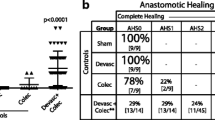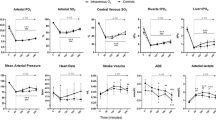Abstract
Inadequate blood flow causing tissue hypoxia can result in failure of anastomotic healing. Tissue oxygen tension (ptO2) measurement has been used to predict anastomotic leakage in animals, but its use in humans has not been described previously. A Clark-type oxygen electrode was used to measure ptO2 on the colon of 50 patients undergoing colonic resection and anastomosis. Baseline ptO2 levels were lowest on the descending colon (31.8±7.4 mmHg, mean ± SD) and tended to increase at all sites with increasing arterial paO2 (r>.76,P<.001). Perianastomotic ptO2 level were predictive of subsequent anastomotic leakage when they were less than either 20 mmHg; 50 percent of the preresection ptO2; 15 percent of the arterial paO2; or 40 percent of the ptO2 at a control site (ileum). It is concluded that perioperative ptO2 measurements are of value in the prediction of anastomotic leakage.
Similar content being viewed by others
References
Hunt TK, Pai MP. The effect of ambient oxygen tensions on wound metabolism and collagen synthesis. Surg Gynecol Obstet 1972;135:561–7.
Kivisaari J, Vihersaari T, Renvall S, Niinikoski J. Energy metabolism of experimental wounds at various oxygen environments. Ann Surg 1975;181:823–8.
Hunt TK, Hawley PR, Hale J, Goodson W, Thakrai KK. Colon repair: the collagenous equilibrium. In: Hunt TK, ed. Wound healing and wound infection: theory and surgical practice. New York: Appleton-Century-Crofts, 1980:153–9.
Clark LC. Monitor and control of blood and tissue oxygen tensions. Trans am Soc Artif Int Organs 1956;2:41–8.
Locke R, Hauser CJ, Shoemaker WC. The use of surface oximetry to assess bowel viability. Arch Surg 1984;119:1252–6.
Piasecki C. First experimental results with the oxygen electrode as a local blood flow sensor in the canine colon. Br J Surg 1985;72: 452–3.
Shandall A, Lowndes R, Young HL. Colonic anastomotic healing and oxygen tension. Br J Surg 1985;72:606–9.
Foster ME, Laycock JRD, Silver IA, Leaper DJ. Hypovolaemia and healing in colonic anastomoses. Br J Surg 1985;72:831–4.
Bussemaker JB, Lindeman J. Comparison of methods to determine viability of small intestine. Ann Surg 1972;176;97–101.
Cooperman M, Martin EW, Keith LM, Carey LC. Use of Doppler ultrasound in intestinal surgery. Am J Surg 1979;138:856–9.
Katz S, Wahab A, Murray W, Williams LF. New parameters of viability in ischaemic bowel disease. Am J Surg 1974;127:136–41.
Zarins CK, Skinner DB, Rhodes BA, Janes AE. Prediction of the viability of revascularized intestine with radioactive microspheres. Surg Gynecol Obstet 1974;138:576–80.
Wright CB, Hobson RW. Prediction of intestinal viability using Doppler ultrasound technics. Am J Surg 1975;129:642–5.
Hulten L, Jodal M, Lindhagen J, Lundgren O. Colonic blood flow in cat and man analysed by an inert gas washout technique. Gastroenterology 1976;70:36–44.
Papachristou D, Fortner JG. Prediction of intestinal viability by intra-arterial dye injection: a simple test. Am J Surg 1976;132: 572–4.
Carter MS, Fantini GA, Sammartano RJ, Mitsudo S, Silverman DG, Boley SJ. Qualitative and quantitative fluorescein fluorescence in determining intestinal viability. Am J Surg 1984;147: 117–23.
Ahn H, Lindhagen J, Nilsson GE, Salerud EG, Jodal M, Lundgren O. Evaluation of laser doppler flowmetry in the assessment of intestinal blood flow in the cat. Gastroenterology 1985;88:951–7.
Author information
Authors and Affiliations
Additional information
Read at the meeting of the American Society of Colon and Rectal Surgeons, Washington, D.C., April 5 to 10, 1987.
W.G.S. was supported by a grant from the Welsh Scheme for Development of Health and Social Research.
About this article
Cite this article
Sheridan, W.G., Lowndes, R.H. & Young, H.L. Tissue oxygen tension as a predictor of colonic anastomotic healing. Dis Colon Rectum 30, 867–871 (1987). https://doi.org/10.1007/BF02555426
Issue Date:
DOI: https://doi.org/10.1007/BF02555426




